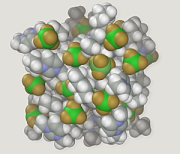
Photo from wikipedia
Abstract This work is devoted to experimental and numerical studies of cavitation phenomena in Venturi tubes with different geometries. A two-phase mixture model has been validated against experimental data. The… Click to show full abstract
Abstract This work is devoted to experimental and numerical studies of cavitation phenomena in Venturi tubes with different geometries. A two-phase mixture model has been validated against experimental data. The numerical results showed good agreement with the experimental data. Experimental studies have been carried out for two different Venturi tubes with convergent angles of 19 ° and 45 ° , respectively. The effect of the convergent angle on the cavitation performance was investigated experimentally and numerically. Both the numerical and experimental studies reveal that the change in the convergent angle has significant effects on flow characteristics and the generation of cavitation. It was shown that a 45 ° convergent angle enhances cavitation in comparison with 19 ° angle. A scaled-up study of the Venturi geometry has been conducted using CFD-based numerical simulations. Finally, a semi-empirical model enabling the prediction of cavitation in Venturi tubes has been developed and validated.
Journal Title: Chemical Engineering Science
Year Published: 2019
Link to full text (if available)
Share on Social Media: Sign Up to like & get
recommendations!